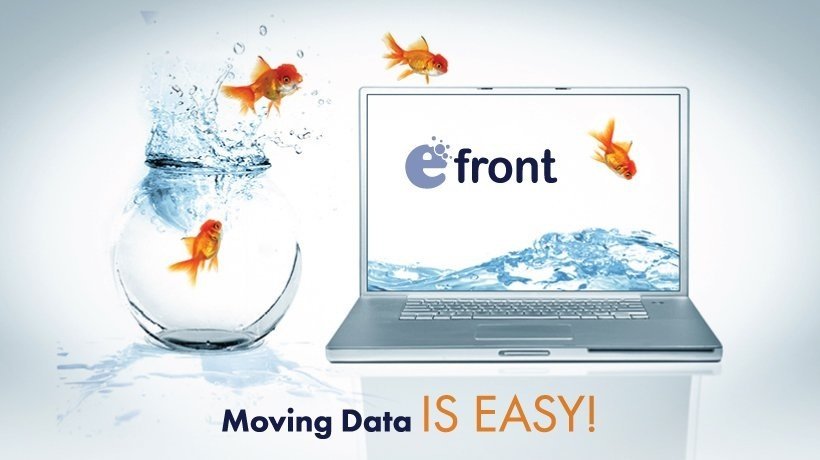Easy LMS Data Export: The Case Of eFrontPro
Half of computing is all about processing data.
The other half is getting them in and out of the computer -- and eLearning is no exception.
Unfortunately, between vendor lock-in, proprietary file formats, no support for standards, and limited export options, a lot of Learning and Talent Development platforms lack in the import/export area. Not eFrontPro though.
In the first part of this article series we had a look at the numerous options eFrontPro offers for getting your data in the platform and into your talent development content.
Today we’ll have a look at LMS data export, meaning how to get your data out, to share results with your boss, import them in your ERP or CRM, to back them up and for any other, legitimate or not, reason you might have. It’s your data after all.
Exporting Your eFrontPro System Entities
Your Talent Development portal manages and stores all kinds of internal data about system entities, like Users, Courses, Curriculums, Branches, Audiences, Groups, etc. In a way, this information defines your eFrontPro-based portal, and on several occasions, it would be handy LMS data export options were available.
Fortunately, you do have these options, and they’re quite easy. At any listing of system entities (e.g. in the Users page, or the Groups page) you will find the option to export the list in industry-standard CSV format.
It is a widely supported format for sharing tabular data, and is totally open, human readable, and compatible with numerous commercial and open source packages (from Excel and R to ERP and eCommerce systems).
What’s better, your IT team can trivially write a small program to parse this CSV file and further process it or import it to any kind of system.
Files Repository
LMS data export is one thing. What about the stuff you’ve uploaded to eFrontPro yourself? You can, you’ll be glad to know, get any files you’ve uploaded, out of it too. So if you want to save an image or another file to your desktop, or share it with someone outside of eFrontPro, you can.
Of course, eFrontPro goes beyond that, with a dedicated File sharing functionality that lets your users organize, reuse and share files, and of course, download them for later study.
Now, all this might sound like a trivial capability, but just try extracting an image that you’ve embedded into a Word Document out of Word -- not that easy, is it? It is astonishing how difficult some programs make exporting content stored inside of them (sometimes dubbed "closed silos" in the industry), and how intuitive it is in eFrontPro.
Calendar Export Support
An unlikely kind of LMS data export is up next, but one that can prove truly useful.
Calendars are an often overlooked, but nevertheless important export option, and one that is fully supported by eFrontPro.
See, eFrontPro supports the industry standard iCal calendar format (also known as ICS), which allows its calendar data to be exported, shared and synced with all major calendar applications on the web (Google Calendar, Outlook.com), desktop (Outlook, Thunderbird, Calendar.app) and mobile (iOS Calendar, etc.).
Users can easily use eFrontPro’s iCal feed to import their eFrontPro calendars to any of those applications, and many more, and have all their calendars in one place.
Exporting Data Through Zapier
We had a look at Zapier, the web-based integration broker service, in the previous post about importing data from other systems into eFrontPro.
Well, Zapier will be just as happy, and equally capable, to help out with your LMS data export, from eFrontPro to any of the thousands of systems it supports.
Using the set of triggers and actions for Zapier and eFrontPro, you can hook any compatible software to receive data like user registration info, course completion details, certifications, etc., from eFrontPro. There are handy manuals that cover this process in detail, but in all, it’s quite intuitive (no programming required, just configuring the integration through a few web forms).
API
The previous methods (with the exception of Zapier) were mostly about getting you data out manually.
But what if you want to automate the process and write some kind of script to get your data out of eFrontPro, process them, and import them into another system, whether that’s a database, your ERP, or anything else?
Well, that is a job for eFrontPro’s API -- a full blown REST-ful HTTP-based API that accepts your queries about eFrontPro entities (Courses, Users, etc.) and gives you back JSON formatted responses. With both REST and JSON being industry standard protocols and formats respectively, with great tooling and vendor support, it is very easy for any IT team or lone programmer (and even a determined non-programmer) to put together some scripts to automate data import and export from eFrontPro.
In fact, we’ve gone beyond providing a REST API, and also created a PHP-based wrapper that automates the tasks of communicating with the API. Of course, if PHP is not your thing, you can query and consume eFrontPro’s API from any other language (Javascript, C#, Java, etc.).
If you want to have a go, you can start at eFrontPro’s API documentation page on GitHub.
Conclusion
In this post (the second of our little series) we had a look at the main ways that LMS data export works in eFrontPro. There still a few importing and exporting tips and tricks that we haven’t covered yet, though, so stay tuned for the next episode.










